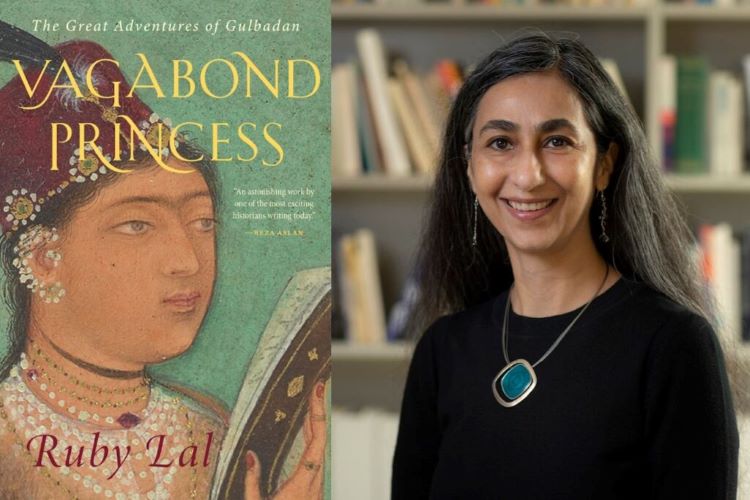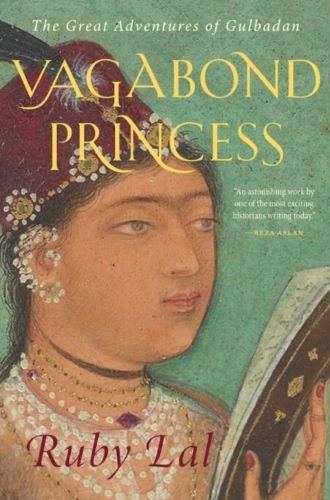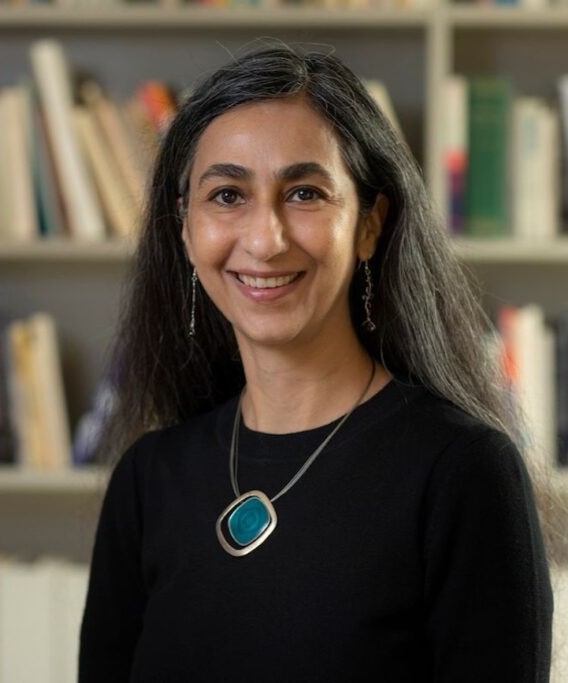
It is the first biography of Princess Gulbadan, the charismatic adventurer and sole woman historian of the Mughal Empire.
BY BHARGAVI KULKARNI
In her new book “Vagabond Princess: The Great Adventures of Gulbadan,” acclaimed feminist historian and Emory University professor Ruby Lal brings to the limelight Princess Gulbadan, the daughter of Emperor Babur, the founder of the Mughal Empire, and the aunt of Emperor Akbar. Considered the sole woman historian of the Mughal Empire, Gulbadan also led a group of women on the first collective female hajj.
Lal’s book, the first biography of Gulbadan,” offers an enthralling portrait of a charismatic adventurer and unique pictures of the multicultural society in which she lives,” according to her website. A synopsis of the book on the national archives website notes that Lal uses “Mughal court documents, miniature paintings, architectural sites, ships, and maritime principles, the political cultures of Ottoman Turkey, Mughal India, and western Arabia, to animate the hitherto untold story behind Gulbadan’s Arabian adventures and the missing pages of her book.”
Who is Gulbadan?
 Gulbadan means “body like a rose flower” or “rose body” in classical Persian. She was about eight years old at the time of her father’s death in 1530 and was brought up by her older half-brother Humayun. She was married to her cousin Khizr Khwaja Khan, a Chagatai noble, at age 17. Following a migratory childhood that spanned Kabul and north India, she spent her middle years in a walled harem established by her nephew Akbar to showcase his authority as the Great Emperor.
Gulbadan means “body like a rose flower” or “rose body” in classical Persian. She was about eight years old at the time of her father’s death in 1530 and was brought up by her older half-brother Humayun. She was married to her cousin Khizr Khwaja Khan, a Chagatai noble, at age 17. Following a migratory childhood that spanned Kabul and north India, she spent her middle years in a walled harem established by her nephew Akbar to showcase his authority as the Great Emperor.
In an interview on the Yale University Press website, Lal said Gulbadan “lived a forceful, itinerant life surrounded by formidable women.” After traveling to Kabul, Agra, and Lahore, in her youth, she came to live behind the red sandstone walls of her nephew Akbar the Great’s harem. “At age 52, she defied her nephew to lead a group of 11 women on a pilgrimage across the Arabian Sea and the Indian Ocean.
After her return, at Akbar’s invitation, she wrote a chronicle in prose. “It was meant to be a source for the first official history of the Empire that Akbar commissioned,” Lal said, adding that the princess “was committed to recording women’s points of view, the places where they lived, what they thought, said and did.”
However, a portion of the book is missing, either lost to history or redacted by officials who did not want the princess to have her say. Lal was intrigued by this, and realized that Gulbadan demands a full biography. So in her new book, she “contemplates the story of the missing pages and breathes new life into a daring historical figure,” her website says. “It offers a portal to a richly complex world, rife with movement and migration, where women’s conviviality, adventure, and autonomies shine through.”
The Wall Street Journal says, ”The book sets out to honor the role of Mughal women and acknowledge their agency. There is much talk of “awe-inspiring ancestresses,” and a chapter called “Female Guardians of the Empire.”
A Feminist Outlook
A profile on Lal published on the Emory University website talks about how she has dealt with “persistent male disbelief,” which she says “marginalizes and thereby erases women-oriented sources.” Through this challenge, feminist history has thrived since its earliest day by “reanimating and reinstalling” memoirs, poetry, art and architecture, “and working through their histories of production,” she said. So, in “Vagabond Princess,” she “takes it upon herself to demonstrate what it is to ‘look where you don’t habitually look.’”
She also attributes the “male disbelief” as the main reason why Gulbadan has been largely forgotten by history. In her book “Domesticity and Power in the Early Mughal World,” which was inspired by Gulbadan’s memoir, Lal shed light on the harem. “I laid out its fundamentals, explained its complex creation, and showed the richly layered lives, tastes, and passions of its denizens,” she says in the Yale interview. She recalled a senior male colleague at the time asking her how she would “write this history, as there so no sources. Her colleague “echoed a question that generations of feminist scholars have heard,” she said.
It was “Domesticity and Power” that brought Gulbadan’s memoir to the world’s attention, she noted in the Yale interview. At the time though, she was “immersed” in the details about the princess’ hajj tour. Gulbadan also appears he early pages of her book “Empress: The Astonishing Reign of Nur Jahan.”
So, as readers got curious about Gulbadan, Lal began a deep dive into the princess. “I, too, returned to questions I had only asked myself in passing,” she said in the Yale interview. “Why had her party stayed in western Arabia for four years? What did they do there? What happened when their ship was wrecked near Aden on the return journey?”
‘Esteemed Memory Holder’
In a March 4 essay in TIME magazine, she described the “bright-eyed” Gulbadan as an “esteemed memory holder, a skilled prose writer.” At a time when “most royal women wrote only poetry,” Akbar trusted her to write the memoir, Lal wrote. “She had lived in the peripatetic royal household through decades of travels and political pursuits. A close witness of her dynasty as it established itself into a great power in India, Gulbadan would be vital in recounting and recording the celebrated achievements of Mughal men.
She described as the book as “unparalleled in form and content,” in which she “broke from the traditional male-dominated focus and instead, narrated jaw-dropping events of her own life, and of the women she had come to know.” The book is “the only account of abundant female Mughal life from that time: filled with quotidian, playful, daring, and eccentric occurrences,” she wrote.
Lal initially came across Gulbadan while writing her doctoral thesis at the University of Oxford, which she attended as the recipient of the Inlaks Shivdasani Foundation Scholarship. “I first encountered the fabulous Gulbadan Begum in 1996 via Beveridge’s English translation,” she writes in her TIME essay. A year later, as she began graduate school in Oxford, she was “obsessed with Gulbadan’s glorious Persian memoir” and “spent a large chunk” of her research at the British Library where it is housed. “The pages of the Princess’s work animate the gritty and fabulous adventures of being alive, subversive women, brilliant eunuchs, cross-dressers, enslaved people, and the precarious lives of children.”
In a profile on the Emory University website, Lal talks about what she admires most about the princess. “The spirit of adventure. I always knew she was powerful and bold, but her setting out once more to experience itinerant life and its attendant freedoms has been amazing to me.”
The Emory website gives a glimpse of how she got interested in Mughal history. Growing up in India, she heard “a range of stories soaked in myth, history and legend,” she says in the profile. “My mother was a fabulous storyteller, and I was besotted by what she related,” she said. She later realized that she was often telling her “a lot about unique girls and women.
During her days at the University of Delhi, she was “not afraid to go against the grain of Indian history students, most of whom specialize in modern history, the colonial period or the 1947 partition of India and Pakistan,” the profile reads. She was instead “fascinated by the great Mughals of India,” who ruled the majority of northern India from the early 16th to mid-18th centuries.
Rave Reviews and Praise
“Vagabond Princess” has received rave reviews and praise from critics and Lal’s contemporaries. The Wall Street Journal says: ”The book sets out to honor the role of Mughal women and acknowledge their agency. There is much talk of “awe-inspiring ancestresses,” and a chapter called “Female Guardians of the Empire.” But again, hard evidence is scarce. “Amid war,” the author writes, female “elders gave advice and younger women brought solace.” We know what solace was, but what was the advice?
Vogue India calls Lal “one of those fine historians who connects bygone events as a thread that firmly binds humans through time. Noting that the book “brings alive an eternally fascinating dimension of 16th-century India,” the review notes that Lal’s “tenacity in chasing this manuscript over two decades across continents and finally sharing it in this lucid form with present-day readers is admirable.
Author and Columbia University professor Gayatri Chakravorty Spivak calls the book “a deeply feminist text interrogating the making of archives, obsessed with imagining the spirit of freedom and love of learning in certain Mughal women, with a stunning buildup of the concept-metaphor of mujawir as ‘vagabond.” It is not only “a splendid teaching text,” but it is also “a reading text for sheer instructive pleasure; as we follow the epistemological performance of the making of the book with the book itself.”
Oxford professor and author Nandini Das says Lal’s book combines “meticulous archival research with a strikingly imaginative evocation of the world inhabited by Mughal women.”She continues: “Whether set against the dust and grit of imperial caravans, salt-lashed sea voyages, or the manicured precision of Mughal gardens, her vagabond princess, Gulbadan, surprises us at every turn. A superb achievement.”
Who is Ruby Lal?
 A professor of South Asian Studies in the Department of Middle Eastern and South Asian Studies at Emory University, she teaches courses such as “Powerful Women in Global History and India’s Women: Leadership, Power and History.”
A professor of South Asian Studies in the Department of Middle Eastern and South Asian Studies at Emory University, she teaches courses such as “Powerful Women in Global History and India’s Women: Leadership, Power and History.”
She holds an M.Phil. in History from the University of Delhi and a D.Phil from the University of Oxford. Before Emory, she taught at the Johns Hopkins University, Baltimore, in History and Anthropology, and served as associate director of the program for the Study of Women, Gender and Sexuality. Her fields of study include feminist history and theory, and the question of archive as it relates to writing about Islamic societies in the precolonial and colonial world.
Read: Kotri – A City of Million Stories
She has written numerous essays and literary pieces in the USA and India. She speaks regularly at national and international conferences, in book clubs, literary festivals, and ecumenical and literary retreats. To request a speaking engagement or other public appearance, please visit the contact page.
She is the author of Empress: The Astonishing Reign of Nur Jahan, Domesticity and Power in the Early Mughal World, and Coming of Age in Nineteenth Century India: The Girl-Child and the Art of Playfulness. She divides her time between Atlanta and Delhi.
She has received numerous fellowships, among them from the Swedish Collegium for Advanced Studies (SCAS), Uppsala, Sweden, and as a Visiting Public Humanities Fellow at the Jackman Humanities Institute at the University of Toronto where she completed her latest book.
(Photo, courtesy of Emory News Center/Emory University. The original photo of Ruby Lal by Danish Saroee)
____________________
Courtesy: American Kahani (Posted on March 21, 2024)